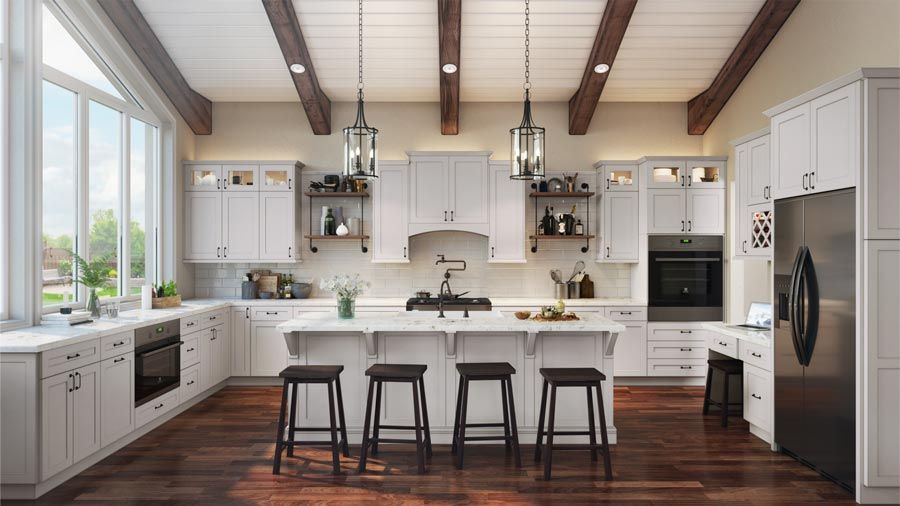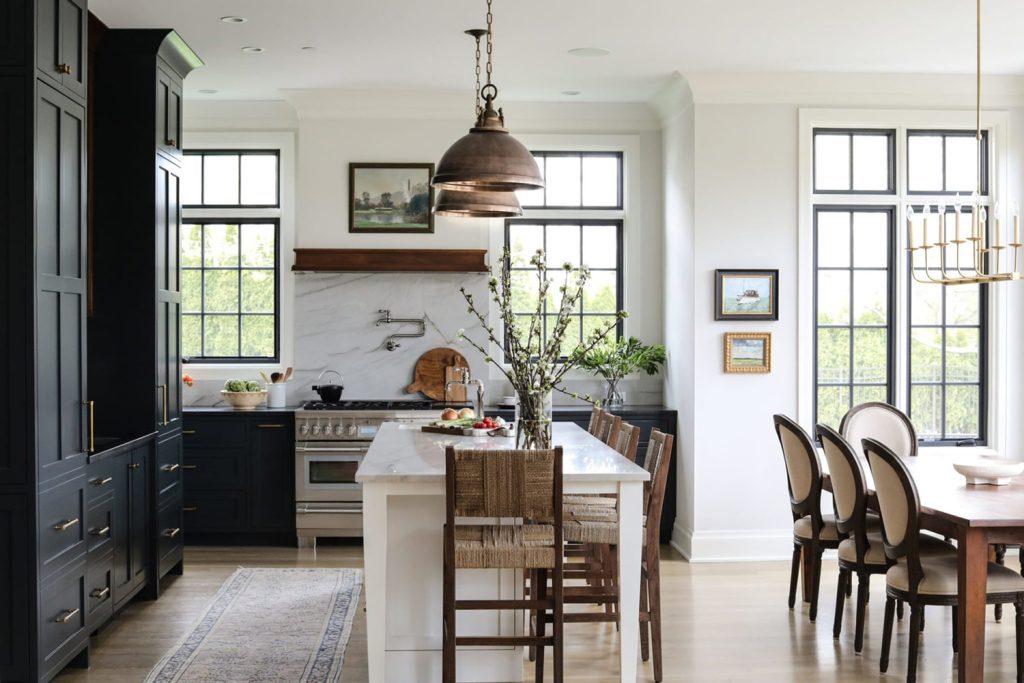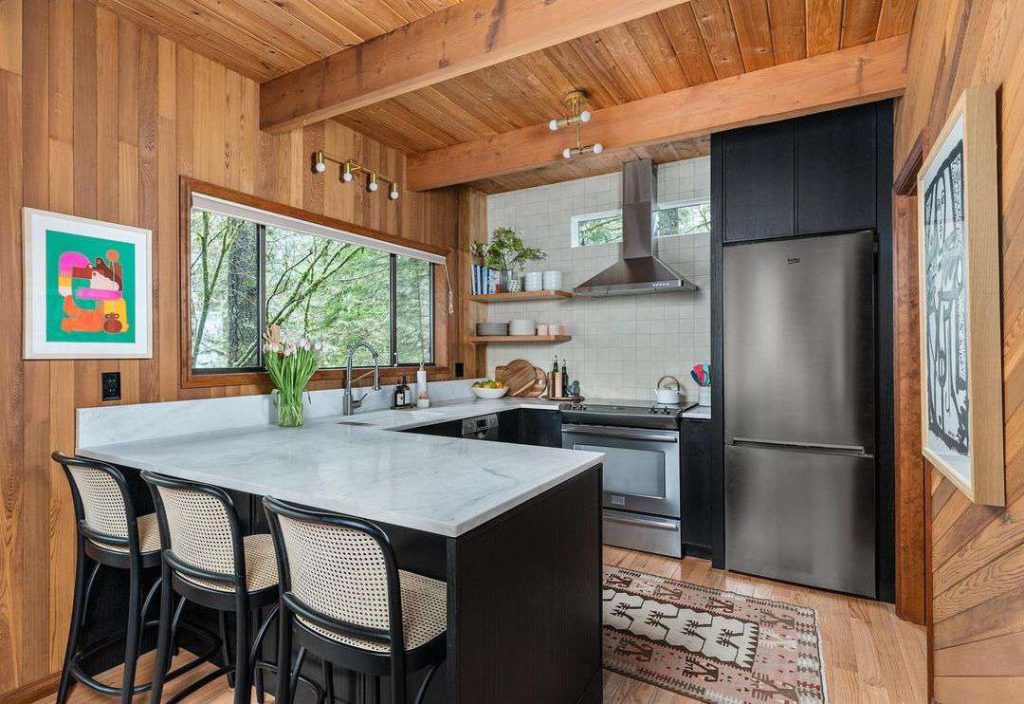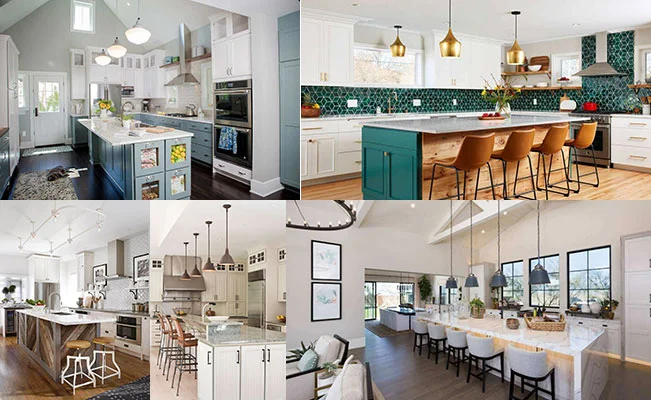Transform your kitchen into a warm, inviting farmhouse haven? Look no further! In this article, I’ll guide you through the process of infusing your kitchen with the nostalgic charm and rustic beauty of farmhouse style. From choosing the perfect color palette to incorporating natural materials and vintage accents, I’ll share essential tips and creative ideas to help you blend the simplicity of the past with the convenience of the modern era. Whether you’re starting from scratch or just looking to add a few rustic touches, this guide will be your companion in creating a kitchen that’s not just functional, but also a heartwarming centerpiece of your home. So, let’s embrace the coziness and character of farmhouse design and embark on a journey to create your dream kitchen!CopyRet
Farmhouse Style: The Basics

Farmhouse style is a blend of rustic charm and modern simplicity, characterized by it’s warm and inviting atmosphere. It’s rooted in practicality and comfort, drawing inspiration from traditional rural architecture and lifestyle. The aesthetic emphasizes natural textures and materials like wood and stone, paired with a neutral color palette. This style often incorporates vintage and antique elements, creating a sense of nostalgia and timelessness. Open spaces, ample light and a focus on functionality are key. Farmhouse decor design isn’t just about appearance; it’s about creating a space that feels welcoming and lived-in, a perfect blend of old and new.
Choosing the Right Color Palette

Choosing the right colors is super important when making a farmhouse-style kitchen. This style mostly uses colors that are neutral, which means they’re not too bold or bright. Think whites, beiges, and light grays. These colors make the kitchen feel calm, bright, and open. They also let the rustic parts of farmhouse design really shine. The neutral colors make the kitchen look bigger and let you add fun decorations that pop. If you want to add a little more warmth and personality, you can also use soft, natural colors like sage green or light blue. Mixing these neutral and soft colors creates the perfect base for a cozy, farmhouse-inspired kitchen.
Incorporating Natural Materials
| Material | Usage in Farmhouse Kitchen | Benefits |
|---|---|---|
| Wood | – Cabinetry and open shelving<br>- Butcher block countertops<br>- Wooden tables and chairs | – Adds warmth and rustic charm<br>- Durable and can be refinished<br>- Versatile in style |
| Stone | – Stone countertops<br>- Stone backsplashes | – Offers a natural, earthy look<br>- Extremely durable<br>- Unique patterns in each piece |
| Metal | – Metal light fixtures<br>- Hardware like knobs and pulls<br>- Metal sink faucets and fixtures | – Adds industrial flair<br>- Durable and long-lasting<br>- Provides contrast against softer materials |
| Clay/Tile | – Tiled backsplashes<br>- Clay pots and decorative items | – Adds texture and color<br>- Customizable designs and patterns<br>- Easy to clean and maintain |
| Glass | – Glass-front cabinets<br>- Glass jars and containers for storage | – Creates a sense of openness<br>- Ideal for displaying kitchenware<br>- Easy to clean and adds a modern touch |
Farmhouse Sink: The Centerpiece

A farmhouse sink, also called an apron-front sink, is a must-have in a farmhouse-style kitchen. You can spot it by its deep bowl and front that sticks out. These sinks are great because they look good and work well. They’re usually bigger than regular sinks, so you can easily wash big pots and pans. Farmhouse sinks can be made from tough materials like fireclay, cast iron, or stainless steel, which gives your kitchen a strong and classic look. These sinks aren’t just for doing dishes and other kitchen chores. They also serve as a beautiful centerpiece that makes your kitchen feel even more rustic and charming, just like a real farmhouse.
Vintage Elements and Antiques

Incorporating vintage elements and antiques is a cornerstone in cultivating an authentic farmhouse kitchen aesthetic. These pieces infuse your space with character, history and a unique charm that new items simply cannot replicate. When integrating vintage pieces, it’s not just about decoration; it’s about storytelling and creating a warm, lived-in atmosphere.
Sourcing Vintage Pieces
Flea markets, estate sales and antique shops are treasure troves for finding one-of-a-kind items. Look for rustic signs, aged wooden furniture, old-fashioned utensils and classic cookware. These items often come with a patina and wear that add depth and texture to your kitchen.
Functional Antiques
Vintage items should be more than just decorative. Consider antique scales, large wooden cutting boards or cast iron cookware. These not only serve as beautiful display pieces but are also functional, adding authenticity to your farmhouse kitchen.
Repurposing with Creativity
Be imaginative in repurposing old items. An antique dresser can be converted into a unique kitchen island or old wooden crates can be used for open shelving or storage. This approach not only recycles and preserves historical pieces but also lends a personal touch to your space.
Balance and Harmony
While vintage elements are essential, it’s important to strike a balance. The goal is to create a harmonious blend of old and new. Too many antiques can make your kitchen feel like a museum, so pair these with modern amenities and simpler designs to maintain a comfortable, livable space.
Decorative Accessories
Smaller antiques like vintage jars, enamelware and classic linens can be used for decoration and storage. These elements contribute to the overall ambiance without overwhelming the space.
Modern Appliances with a Traditional Twist

Integrating modern appliances with a traditional twist is key in achieving a functional yet authentic farmhouse kitchen. This approach combines the convenience of contemporary technology with the rustic charm of farmhouse aesthetics, ensuring your kitchen is both efficient and stylistically cohesive.
Choosing Appliances
When selecting appliances, opt for designs that evoke a sense of nostalgia while offering the latest in culinary technology. Brands now offer ranges, refrigerators and dishwashers with vintage-inspired designs. Look for appliances with retro lines, classic colors like cream or pastel shades and details like analog dials or brass accents.
Refrigerators
Modern refrigerators with a vintage look are a perfect addition. They come in various pastel colors or with paneled doors that blend seamlessly with your cabinetry, maintaining the traditional feel without compromising on functionality.
Ranges and Ovens
A range or oven is often the centerpiece of a farmhouse kitchen. Select models that mimic old-world designs, such as those with ornate detailing or a matte finish. These appliances provide the advanced cooking technology you need while enhancing the kitchen’s rustic charm.
Dishwashers
Modern dishwashers can be discreetly integrated into a farmhouse kitchen. Choose a model that can be paneled to match your cabinetry or opt for a freestanding piece in a design consistent with the era, offering efficiency without detracting from the vintage feel.
Small Appliances
Don’t overlook small appliances. Items like toasters, stand mixers and coffee makers are available in designs that reflect the farmhouse aesthetic. These pieces add a quaint touch to countertops and are practical for daily use.
Textural Contrast and Layering
Textural contrast and layering play a pivotal role in creating the rich, inviting ambiance of a farmhouse kitchen. This involves mixing different materials and finishes to add depth and interest. Smooth, polished surfaces like granite countertops can be juxtaposed with rough, rustic textures like reclaimed wood shelving. Layering comes through in details like braided rugs on hardwood floors, linen curtains or woven baskets. These elements not only contribute to the tactile experience but also help to break the monotony, making the kitchen more dynamic. This approach to texture and layering ensures the space feels cozy, well-lived-in and full of character.
Lighting
Lighting is a crucial element in a farmhouse kitchen, setting the mood and highlighting the room’s best features. Opt for fixtures that exude a rustic charm, such as wrought iron lanterns, vintage-inspired pendant lights or mason jar chandeliers. These not only illuminate the space but also act as decorative pieces, enhancing the farmhouse ambiance. Ensure a mix of ambient, task and accent lighting to create a warm and inviting atmosphere. Soft, warm light bulbs can mimic the glow of natural light, adding to the cozy feel. Proper lighting transforms a kitchen, making it a welcoming hub for family and friends.
Open Shelving and Practical Storage
Open shelving is a signature feature in farmhouse kitchens, offering both practicality and aesthetic appeal. It allows for easy access to everyday items while providing a space to display charming dishes, vintage finds and decorative objects. To maintain a clutter-free look, balance open shelves with traditional cabinetry for hidden storage. Use baskets and bins to organize and conceal less attractive essentials. Incorporating a mix of open and closed storage solutions ensures the kitchen remains functional and tidy, while the open shelving adds a touch of rustic charm and a sense of openness to the farmhouse kitchen design.
Farmhouse-Style Seating
| Seating Option | Features | Contribution to Farmhouse Style |
|---|---|---|
| Wooden Benches | – Sturdy construction<br>- Can be painted or left natural | – Adds a communal, rustic feel<br>- Perfect for family-style dining |
| Spindle-Back Chairs | – Classic design with vertical slats<br>- Often made of wood | – Provides a traditional, homey touch<br>- Versatile for various table styles |
| Upholstered Chairs | – Cushioned seats<br>- Fabric choices like gingham or linen | – Offers comfort<br>- Introduces texture and pattern |
| Windsor Chairs | – Iconic design with a curved back<br>- Spindle details | – Exudes elegance and simplicity<br>- Blends well with both modern and rustic tables |
| Bar Stools | – For kitchen islands or counter seating<br>- Available in various heights | – Practical for casual dining<br>- Can be chosen to match cabinetry or accents |
| Window Seat | – Built-in seating near a window<br>- Often includes storage underneath | – Creates a cozy nook<br>- Ideal for small spaces and adds extra storage |
Decorative Touches
- Fresh Flowers and Plants: Adds a touch of nature and freshness.
- Vintage Canisters and Jars: Perfect for storing kitchen essentials while adding a rustic charm.
- Wooden Cutting Boards: Functional and aesthetically pleasing, especially when displayed.
- Antique Cookware: Copper pots and cast-iron pans can be both decorative and practical.
- Textile Accents: Linen tablecloths, burlap runners and cotton dish towels contribute softness and warmth.
- Rustic Wall Art: Farm-themed paintings or vintage signs can enhance the farmhouse feel.
- Mason Jar Decor: Ideal for storage, vases or as light fixtures.
- Chalkboards: Useful for menus or notes, adding a whimsical, old-school touch.
- Woven Baskets: Great for storage and adding texture.
- Ceramic Dishes: Displayed on open shelving, they add color and pattern.
Frequently Asked Questions (FAQs)
Neutral tones like white, cream and light gray are ideal for creating a farmhouse look. They provide a clean, airy backdrop that complements rustic elements.
Absolutely. Many modern appliances come in designs that mimic traditional styles, allowing you to enjoy the latest technology without compromising on aesthetics.
Focus on small changes like painting cabinets, adding a vintage rug or replacing hardware with antique-style knobs and pulls. These changes can make a big impact without a large investment.
Conclusion
Transforming your kitchen into a farmhouse-inspired haven is an artful blend of the old and the new. It’s about embracing simplicity, warmth and rustic charm while ensuring functionality and comfort. By carefully selecting color palettes, incorporating natural materials, adding vintage elements and balancing modern appliances with traditional designs, you create more than just a style; you cultivate an experience. Textural contrasts, thoughtful lighting, practical storage, characteristic seating and decorative touches all contribute to this unique aesthetic. Each element plays a part in crafting a kitchen that is not only a culinary workspace but a heartwarming centerpiece of your home.




